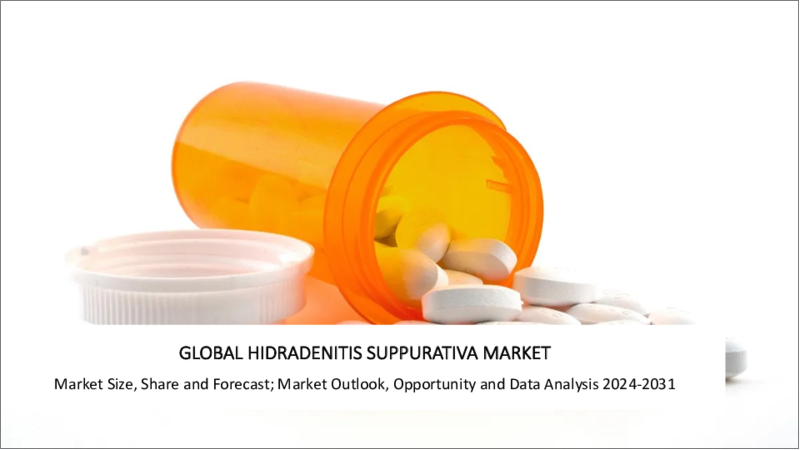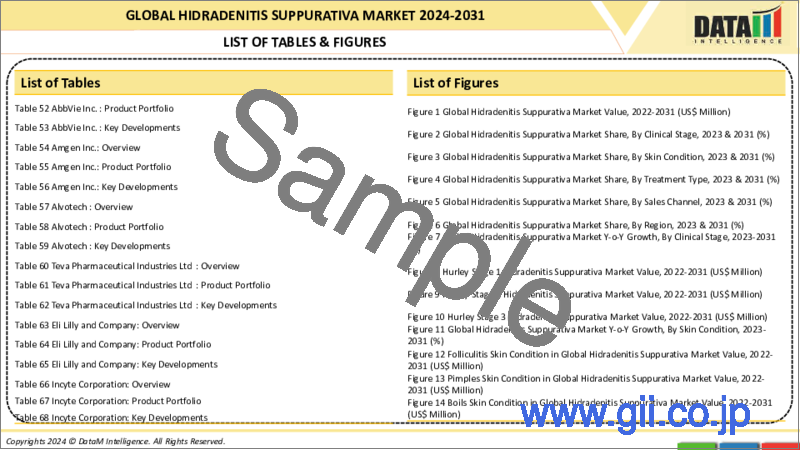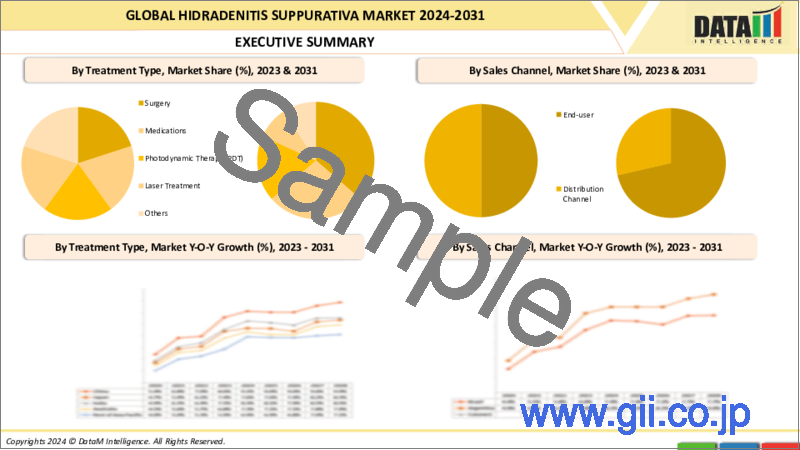|
|
市場調査レポート
商品コード
1297810
化膿性汗腺炎の世界市場-2023年~2030年Global Hidradenitis Suppurativa Market - 2023-2030 |
||||||
カスタマイズ可能
適宜更新あり
|
|||||||
| 化膿性汗腺炎の世界市場-2023年~2030年 |
|
出版日: 2023年06月15日
発行: DataM Intelligence
ページ情報: 英文 200 Pages
納期: 即日から翌営業日
|
- 全表示
- 概要
- 目次
市場概要
世界の化膿性汗腺炎市場は、2022年に7億2,560万米ドルに達し、2030年には11億米ドルまで成長すると予測されています。世界の化膿性汗腺炎市場は、2023年から2030年の予測期間中に4.8%のCAGRを示すと予測されています。
皮膚科医や皮膚外科医は、化膿性汗腺炎の患者を診断・治療する医療専門家の一人です。彼らは症状の重症度を判断し、適切な治療法(抗生物質、抗炎症薬、免疫抑制剤など)を推奨し、創傷の治療や疼痛管理の方法を指導します。
市場力学
積極的な主要プレーヤーが、予測期間中の世界の化膿性汗腺炎市場の成長を後押ししています
活発な主要プレーヤーと政府による承認が市場を牽引しています。例えば、2023年6月、欧州委員会(EC)は、標準的な全身性化膿性汗腺炎治療で十分な効果が得られない活動性の中等度から重度の化膿性汗腺炎患者への使用について、ノバルティス社のコセンティクス(secukinumab)を承認しました。
全世界で100万人以上がコセンティクスによる治療を受けています。ノバルティスは、化膿性汗腺炎の患者さんに迅速かつ長期的な症状緩和を提供し、高い評価を得ている治療オプションとしてコセンティクスを提供しています。
ノバルティスは、確立された患者支援プログラムおよび市場参入プログラムにより、コセンティクスへの迅速かつ広範なアクセスを促進するのに有利な立場にあります。この画期的な承認は、緊急の医療ニーズに対応する高品質な医薬品を提供するという当社の目標が大きく前進したことを意味します。
化膿性汗腺炎の患者数の増加が、予測期間中の化膿性汗腺炎市場の成長を後押ししています
2022年にClinical Dermatology Review誌に掲載された論文によると、化膿性汗腺炎は以前考えられていたよりも蔓延しており、推定人口有病率は1%~4%です。化膿性汗腺炎の発生を正しく推定することは、誤診や正確な人口統計の欠如によってさらに複雑になっています。
思春期以降、化膿性汗腺炎はしばしば発症し、ほとんどの人は20代から30代で症状を経験します。症例の分布に関しては、女性が多いです。生物学的製剤であるアダリムマブ(ADA)が第一選択薬として広く採用されたことにより、様々な生物学的製剤の化膿性汗腺炎治療における有効性が検討され始めています。
産学連携は世界化膿性汗腺炎市場の成長機会を提供します
例えば、2022年3月、皮膚の健康に特化した多国籍バイオ医薬品企業であるAlmirall, S.A.は、慢性炎症性皮膚疾患である化膿性汗腺炎の誘因に関する知識を深めるため、ミシガン大学と提携しました。
この提携により、ミシガン大学のヨハン・E・グジョンソン博士の皮膚科とアルミラール社の皮膚疾患に関する専門知識が融合され、慢性疾患の解離や線維化など、この疾患の本質的な特徴が研究されることになります。
COVID-19の影響分析
COVID-19の流行は、化膿性汗腺炎市場に大きな影響を与えています。数多くのヘルスケア専門家が遠隔医療やバーチャル・ケア・プラットフォームを活用し、COVID-19感染のリスクを減らしています。これらの技術は患者と医療スタッフとの間に異なるコミュニケーションチャネルを提供するが、特に身体検査や処置が必要な場合には、HS管理のすべての側面にとって最良の選択肢とはならないかもしれないです。
ロシア・ウクライナ紛争分析
ロシア・ウクライナ紛争が化膿性汗腺炎市場に与える影響は複雑かつ多面的です。紛争や暴力の間はヘルスケアへのアクセスが妨げられる可能性があります。病院や医療施設が被害を受けたり、アクセスできなくなったりする一方で、ヘルスケア従事者は転居を余儀なくされたり、緊急治療に追われたりする可能性があります。このことは、影響を受けた地域に住む人々の健康診断、治療、管理に影響を与える可能性があります。
目次
第1章 調査手法と範囲
第2章 定義と概要
第3章 エグゼクティブサマリー
第4章 市場力学
- 影響を与える要因
- 促進要因
- 化膿性汗腺炎の有病率の増加
- 抑制要因
- 治療に伴う高額な費用
- 機会
- 研究開発活動の増加
- 影響分析
- 促進要因
第5章 業界分析
- ポーターのファイブフォース分析
- サプライチェーン分析
- アンメットニーズ
- 規制分析
第6章 COVID-19の分析
第7章 ロシアとウクライナの戦争分析
第8章 人工知能分析
第9章 臨床段階別
- ハーレーステージ1
- ハーレーステージ2
- ハーレーステージ3
第10章 肌の状態別
- 毛嚢炎
- ニキビ
- 沸騰する
- 深いニキビ
- その他
第11章 治療タイプ別
- 手術
- 薬
- 生物製剤
- 抗生物質
- ホルモン療法
- 免疫抑制薬
- 亜鉛サプリメント
- レチノイド
- 鎮痛薬
- 光線力学療法(PDT)
- レーザー治療
- その他
第12章 投与経路別
- オーラル
- 非経口
- その他
第13章 エンドユーザー別
- 病院
- 専門クリニック
- ホームケア
- その他
第14章 流通チャネル別
- 病院薬局
- 小売薬局
- オンライン薬局
- その他
第15章 地域別
- 北米
- 米国
- カナダ
- メキシコ
- 欧州
- ドイツ
- 英国
- フランス
- イタリア
- スペイン
- その他欧州
- 南米
- ブラジル
- アルゼンチン
- その他南米
- アジア太平洋
- 中国
- インド
- 日本
- オーストラリア
- その他アジア太平洋地域
- 中東とアフリカ
第16章 競合情勢
- 競合シナリオ
- 製品のベンチマーク
- 企業シェア分析
- 主な発展と戦略
第17章 企業プロファイル
- Pfizer Inc.
- 会社概要
- 製品ポートフォリオと説明
- 財務概要
- 主な発展
- Eli Lilly and Company
- AbbVie Inc.
- UCB SA
- Incyte Corporation
- Novartis AG
- Boehringer Ingelheim
- Aclaris Therapeutics, Inc.
- InflaRx NV
- Moonlake Immunotherapeutics
第18章 付録
Market Overview
The Global Hidradenitis Suppurativa Market reached US$ 725.6 million in 2022 and is projected to witness lucrative growth by reaching up to US$ 1.1 billion by 2030. The Global Hidradenitis Suppurativa Market is expected to exhibit a CAGR of 4.8% during the forecast period 2023-2030.
Dermatologists and Dermatologic surgeons are among the healthcare experts who diagnose and treat hidradenitis suppurative patients. They determine the condition's severity, recommend the proper therapies (such as antibiotics, anti-inflammatory medications, and immunosuppressants), and offer instructions on how to treat wounds and manage pain.
Market Dynamics
Active key players are boosting the global hidradenitis suppurativa market growth during the forecast period.
Active key players and approval by the government drive the market. For instance, in June 2023, The European Commission (EC) authorized Cosentyx (secukinumab) by Novartis for use in individuals with active moderate to severe hidradenitis suppurative who have not responded adequately to standard systemic hidradenitis suppurative therapy.
More than 1 million people have received treatment with Cosentyx worldwide. The company offers Cosentyx as a well-respected therapy option, providing hidradenitis suppurative sufferers with quick and long-lasting symptom alleviation.
Novartis is well-positioned to facilitate quick and extensive access to Cosentyx because of its well-established patient assistance and market access programs. This milestone approval represents a significant advancement in our goal of providing high-quality medications that address urgent medical needs.
An increasing number of patients with hidradenitis suppurativa is boosting the Global Hidradenitis Suppurativa Market growth during the forecast period.
As per the article published in Clinical Dermatology Review in 2022, hidradenitis suppurativa is more prevalent than previously believed, with an estimated population prevalence of 1% to 4%. The right estimation of the occurrence of hidradenitis suppurativa is further complicated by misdiagnosis and a lack of precise demographic statistics.
After puberty, hidradenitis suppurativa frequently develops, with most individuals experiencing symptoms in their 20s and 30s. When it comes to case distribution, women predominate. The effectiveness of various biologic drugs in the treatment of hidradenitis suppurativa has started to be investigated due to the widespread adoption of the biologic agent adalimumab (ADA) as a first-line therapeutic agent.
Industry-academia partnership provides Global Hidradenitis Suppurativa Market growth opportunities.
For instance, in March 2022, Almirall, S.A., a multinational biopharmaceutical business specializing in skin health, partnered with the University of Michigan to advance knowledge of the triggers of the chronic, inflammatory skin disorder hidradenitis suppurativa.
Through this collaboration, Dr. Johann E. Gudjonsson's dermatology department at the University of Michigan and Almirall's expertise in skin disorders will be merged to study essential features of this illness, such as chronic disease dissection and fibrosis.
COVID-19 Impact Analysis
The COVID-19 pandemic has had a significant impact on the Hidradenitis Suppurativa market. Numerous healthcare professionals have utilized telemedicine and virtual care platforms to reduce the risk of COVID-19 transmission. Although these technologies offer a different communication channel between patients and medical staff, they might not be the best option for all facets of HS management, particularly when physical examinations and procedures are required.
Russia-Ukraine Conflict Analysis
The impact of the Russia-Ukraine war on the hidradenitis suppurativa market is complex and multifaceted. Access to healthcare may be hampered during periods of unrest and violence. Healthcare workers may be relocated or occupied with emergency treatment, while hospitals and medical facilities may be damaged or inaccessible. This may affect HS diagnosis, treatment, and management for people living in the impacted locations.
Segment Analysis
The Global Hidradenitis Suppurativa Market is segmented based on clinical stage, skin condition, treatment type, route of administration, end-user, distribution channel, and region.
The medications segment is expected to hold a dominant position in the market over the forecast period.
The medications segment had the highest market stake, accounting for approximately 32.5% of the Hidradenitis Suppurativa market in 2022. If tests reveal a bacterial infection and lumps that are extremely painful, inflamed, and leaking pus, then you may be given a 1- or 2-week course of antibiotics. Low doses of antibiotics may be used to stop inflammation if bacterial infection is absent. A longer course of antibiotics will be taken for at least three months to lessen the number of lumps that form.
Antibiotics can be administered orally, topically (as a cream), or as tablets, capsules, or liquids. Lymecycline, doxycycline, erythromycin, and clarithromycin are different antibiotic kinds. Clindamycin and rifampicin together are beneficial in treating severe cases of hidradenitis suppurativa.
Geographical Analysis
Increasing collaborations and partnerships among the key players and advancement in hidradenitis suppurativa dominate the European region.
Europe is expected to dominate secondly the hidradenitis suppurativa market, accounting for around 25.5% of this market. For instance, in February 2023, Povorcitinib (previously INCB54707) is an oral JAK1 inhibitor that Incyte has reported new 52-week findings from a Phase 2 study examining its effectiveness and safety in treating adult patients with hidradenitis suppurative (HS).
The study previously met its primary endpoint, showing that at Week 16 of the double-blind, placebo-controlled phase, patients receiving povorcitinib once daily (QD) had significantly greater decreases from baseline in Abscess and Inflammatory Nodule (AN) count compared to placebo (least squares mean change, 2.5 [0.9], placebo vs. 5.2 [0.9], P=0.0277, povorcitinib 15 mg; 6.9.
Competitive Landscape
The major global players in the market include: Pfizer Inc., Eli Lilly and Company, AbbVie Inc., UCB S.A., Incyte Corporation, Novartis AG, Boehringer Ingelheim, Aclaris Therapeutics, Inc., InflaRx N.V., and Moonlake Immunotherapeutics among others.
Why Purchase the Report?
- To visualize the Global Hidradenitis Suppurativa Market segmentation based on the clinical stage, skin condition, treatment type, route of administration, end-user, distribution channel, and region, as well as understand key commercial assets and players.
- Identify commercial opportunities by analyzing trends and co-development.
- Excel data sheet with numerous hidradenitis suppurativa market-level data points with all segments.
- PDF report consists of a comprehensive analysis after exhaustive qualitative interviews and an in-depth study.
- Product mapping available as Excel consisting of key products of all the major players.
The Global Hidradenitis Suppurativa Market Report Would Provide Approximately 85 Tables, 93 Figures And 200+ pages.
Target Audience 2023
- Manufacturers/ Buyers
- Industry Investors/Investment Bankers
- Research Professionals
- Emerging Companies
Table of Contents
1. Methodology and Scope
- 1.1. Research Methodology
- 1.2. Research Objective and Scope of the Report
2. Definition and Overview
3. Executive Summary
- 3.1. Snippet by Clinical Stage
- 3.2. Snippet by Skin Condition
- 3.3. Snippet by Treatment Type
- 3.4. Snippet by Route of Administration
- 3.5. Snippet by Distribution Channel
- 3.6. Snippet by End-user
- 3.7. Snippet by Region
4. Dynamics
- 4.1. Impacting Factors
- 4.1.1. Drivers
- 4.1.1.1. Increasing Prevalence of hidradenitis suppurativa
- 4.1.2. Restraints
- 4.1.2.1. High cost associated with the treatment
- 4.1.3. Opportunity
- 4.1.3.1. Increasing research and development activities
- 4.1.4. Impact Analysis
- 4.1.1. Drivers
5. Industry Analysis
- 5.1. Porter's 5 Forces Analysis
- 5.2. Supply Chain Analysis
- 5.3. Unmet Needs
- 5.4. Regulatory Analysis
6. COVID-19 Analysis
- 6.1. Analysis of COVID-19
- 6.1.1. Scenario Before COVID-19
- 6.1.2. Scenario During COVID-19
- 6.1.3. Scenario Post COVID-19
- 6.2. Pricing Dynamics Amid COVID-19
- 6.3. Demand-Supply Spectrum
- 6.4. Government Initiatives Related to the Market During the Pandemic
- 6.5. Manufacturers' Strategic Initiatives
- 6.6. Conclusion
7. Russia-Ukraine War Analysis
8. Artificial Intelligence Analysis
9. By Clinical Stage
- 9.1. Introduction
- 9.1.1. Market Size Analysis and Y-o-Y Growth Analysis (%), By Clinical Stage
- 9.1.2. Market Attractiveness Index, By Clinical Stage
- 9.2. Hurley Stage 1*
- 9.2.1. Introduction
- 9.2.2. Market Size Analysis and Y-o-Y Growth Analysis (%)
- 9.3. Hurley Stage 2
- 9.4. Hurley Stage 3
10. By Skin Condition
- 10.1. Introduction
- 10.1.1. Market Size Analysis and Y-o-Y Growth Analysis (%), By Skin Condition
- 10.1.2. Market Attractiveness Index, By Skin Condition
- 10.2. Folliculitis*
- 10.2.1. Introduction
- 10.2.2. Market Size Analysis and Y-o-Y Growth Analysis (%)
- 10.3. Pimples
- 10.4. Boils
- 10.5. Deep-Acne
- 10.6. Others
11. By Treatment Type
- 11.1. Introduction
- 11.1.1. Market Size Analysis and Y-o-Y Growth Analysis (%), By Treatment Type
- 11.1.2. Market Attractiveness Index, By Treatment Type
- 11.2. Surgery*
- 11.2.1. Introduction
- 11.2.2. Market Size Analysis and Y-o-Y Growth Analysis (%)
- 11.3. Medications
- 11.3.1. Biologics
- 11.3.2. Antibiotics
- 11.3.3. Hormonal Therapy
- 11.3.4. Immunosuppressive Drugs
- 11.3.5. Zinc Supplements
- 11.3.6. Retinoids
- 11.3.7. Pain Medication
- 11.4. Photodynamic Therapy (PDT)
- 11.5. Laser Treatment
- 11.6. Others
12. By Route of Administration
- 12.1. Introduction
- 12.1.1. Market Size Analysis and Y-o-Y Growth Analysis (%), By Route of Administration
- 12.1.2. Market Attractiveness Index, By Route of Administration
- 12.2. Oral*
- 12.2.1. Introduction
- 12.2.2. Market Size Analysis and Y-o-Y Growth Analysis (%)
- 12.3. Parenteral
- 12.4. Others
13. By End-user
- 13.1. Introduction
- 13.1.1. Market Size Analysis and Y-o-Y Growth Analysis (%), By End-user
- 13.1.2. Market Attractiveness Index, By End-user
- 13.2. Hospitals*
- 13.2.1. Introduction
- 13.2.2. Market Size Analysis and Y-o-Y Growth Analysis (%)
- 13.3. Specialty Clinics
- 13.4. Homecare
- 13.5. Others
14. By Distribution Channel
- 14.1.1. Market Size Analysis and Y-o-Y Growth Analysis (%), By Distribution Channel
- 14.1.2. Market Attractiveness Index, By Distribution Channel
- 14.2. Hospital Pharmacy*
- 14.2.1. Introduction
- 14.2.2. Market Size Analysis and Y-o-Y Growth Analysis (%)
- 14.3. Retail Pharmacy
- 14.4. Online Pharmacy
- 14.5. Others
15. By Region
- 15.1. Introduction
- 15.1.1. Market Size Analysis and Y-o-Y Growth Analysis (%), By Region
- 15.1.2. Market Attractiveness Index, By Region
- 15.2. North America
- 15.2.1. Introduction
- 15.2.2. Key Region-Specific Dynamics
- 15.2.3. Market Size Analysis and Y-o-Y Growth Analysis (%), By Clinical stage
- 15.2.4. Market Size Analysis and Y-o-Y Growth Analysis (%), By Skin Condition
- 15.2.5. Market Size Analysis and Y-o-Y Growth Analysis (%), By Treatment Type
- 15.2.6. Market Size Analysis and Y-o-Y Growth Analysis (%), By Route of Administration
- 15.2.7. Market Size Analysis and Y-o-Y Growth Analysis (%), By End-user
- 15.2.8. Market Size Analysis and Y-o-Y Growth Analysis (%), By Distribution Channel
- 15.2.9. Market Size Analysis and Y-o-Y Growth Analysis (%), By Country
- 15.2.9.1. The U.S.
- 15.2.9.2. Canada
- 15.2.9.3. Mexico
- 15.3. Europe
- 15.3.1. Introduction
- 15.3.2. Key Region-Specific Dynamics
- 15.3.3. Market Size Analysis and Y-o-Y Growth Analysis (%), By Clinical stage
- 15.3.4. Market Size Analysis and Y-o-Y Growth Analysis (%), By Skin Condition
- 15.3.5. Market Size Analysis and Y-o-Y Growth Analysis (%), By Treatment Type
- 15.3.6. Market Size Analysis and Y-o-Y Growth Analysis (%), By Route of Administration
- 15.3.7. Market Size Analysis and Y-o-Y Growth Analysis (%), By End-user
- 15.3.8. Market Size Analysis and Y-o-Y Growth Analysis (%), By Distribution Channel
- 15.3.9. Market Size Analysis and Y-o-Y Growth Analysis (%), By Country
- 15.3.9.1. Germany
- 15.3.9.2. The U.K.
- 15.3.9.3. France
- 15.3.9.4. Italy
- 15.3.9.5. Spain
- 15.3.9.6. Rest of Europe
- 15.4. South America
- 15.4.1. Introduction
- 15.4.2. Key Region-Specific Dynamics
- 15.4.3. Market Size Analysis and Y-o-Y Growth Analysis (%), By Clinical stage
- 15.4.4. Market Size Analysis and Y-o-Y Growth Analysis (%), By Skin Condition
- 15.4.5. Market Size Analysis and Y-o-Y Growth Analysis (%), By Treatment Type
- 15.4.6. Market Size Analysis and Y-o-Y Growth Analysis (%), By Route of Administration
- 15.4.7. Market Size Analysis and Y-o-Y Growth Analysis (%), By End-user
- 15.4.8. Market Size Analysis and Y-o-Y Growth Analysis (%), By Distribution Channel
- 15.4.9. Market Size Analysis and Y-o-Y Growth Analysis (%), By Country
- 15.4.9.1. Brazil
- 15.4.9.2. Argentina
- 15.4.9.3. Rest of South America
- 15.5. Asia-Pacific
- 15.5.1. Introduction
- 15.5.2. Key Region-Specific Dynamics
- 15.5.3. Market Size Analysis and Y-o-Y Growth Analysis (%), By Clinical stage
- 15.5.4. Market Size Analysis and Y-o-Y Growth Analysis (%), By Skin Condition
- 15.5.5. Market Size Analysis and Y-o-Y Growth Analysis (%), By Treatment Type
- 15.5.6. Market Size Analysis and Y-o-Y Growth Analysis (%), By Route of Administration
- 15.5.7. Market Size Analysis and Y-o-Y Growth Analysis (%), By End-user
- 15.5.8. Market Size Analysis and Y-o-Y Growth Analysis (%), By Distribution Channel
- 15.5.9. Market Size Analysis and Y-o-Y Growth Analysis (%), By Country
- 15.5.9.1. China
- 15.5.9.2. India
- 15.5.9.3. Japan
- 15.5.9.4. Australia
- 15.5.9.5. Rest of Asia-Pacific
- 15.6. Middle East and Africa
- 15.6.1. Introduction
- 15.6.2. Key Region-Specific Dynamics
- 15.6.3. Market Size Analysis and Y-o-Y Growth Analysis (%), By Clinical stage
- 15.6.4. Market Size Analysis and Y-o-Y Growth Analysis (%), By Skin Condition
- 15.6.5. Market Size Analysis and Y-o-Y Growth Analysis (%), By Treatment Type
- 15.6.6. Market Size Analysis and Y-o-Y Growth Analysis (%), By Route of Administration
- 15.6.7. Market Size Analysis and Y-o-Y Growth Analysis (%), By End-user
- 15.6.8. Market Size Analysis and Y-o-Y Growth Analysis (%), By Distribution Channel
16. Competitive Landscape
- 16.1. Competitive Scenario
- 16.2. Product Benchmarking
- 16.3. Company Share Analysis
- 16.4. Key Developments and Strategies
17. Company Profiles
- 17.1. Pfizer Inc.*
- 17.1.1. Company Overview
- 17.1.2. Product Portfolio and Description
- 17.1.3. Financial Overview
- 17.1.4. Key Developments
- 17.2. Eli Lilly and Company
- 17.3. AbbVie Inc.
- 17.4. UCB S.A.
- 17.5. Incyte Corporation
- 17.6. Novartis AG
- 17.7. Boehringer Ingelheim
- 17.8. Aclaris Therapeutics, Inc.
- 17.9. InflaRx N.V.
- 17.10. Moonlake Immunotherapeutics
LIST NOT EXHAUSTIVE
18. Appendix
- 18.1. About Us and Services
- 18.2. Contact Us





